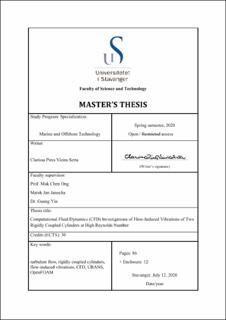| dc.contributor.advisor | Ong, Muk Chen | |
| dc.contributor.advisor | Janocha, Marek Jan | |
| dc.contributor.advisor | Yin, Guang | |
| dc.contributor.author | Pires Vieira Serta, Clarissa | |
| dc.date.accessioned | 2020-09-18T12:50:49Z | |
| dc.date.available | 2020-09-18T12:50:49Z | |
| dc.date.issued | 2020 | |
| dc.identifier.uri | https://hdl.handle.net/11250/2678524 | |
| dc.description | Master's thesis in Offshore Technology | en_US |
| dc.description.abstract | Two degree-of-freedom (2-DoF) flow-induced vibrations (FIV) of a single cylinder and two rigidly coupled cylinders are numerically investigated at the Reynolds number of 3.6 × 10^6. Two-dimensional (2D) Unsteady Reynolds-Averaged Navier-Stokes (URANS) simulations are performed combined with the k-ω SST turbulence model. A low mass-damping system is considered with the mass ratio set to 2 and the damping ratio to zero. For the coupled cylinders configurations, the diameter ratio is set to 0.25. A parametric study is performed to analyse the influence of the reduced velocity (Ur), the position angle (α) of the small cylinder relative to the large cylinder and the gap ratio (G⁄D) between the cylinders on the FIV response of the system. For the single cylinder, the simulations are performed for 2.5≤Ur≤12, and for the coupled cylinders, for 2≤Ur≤12. To analyse the effect of α, three values are considered, [α=0°, 90°, 180°] with a constant value of G⁄D=0.1. The effect of G⁄D is studied for the α=90° configuration in which the G⁄D=0.25 and G⁄D=0.5 configurations are analysed in addition to the G⁄D=0.1 cases. A good grid convergence is obtained and the numerical model is validated against published results for a stationary single cylinder. It is found that the lock-in regime extends beyond Ur=12 for the α=0°, 180° and α=90° at G⁄D=0.1, 0.25 configurations compared with the single cylinder configuration. Galloping response is observed when the small cylinder is placed at α=90°, with G⁄D=0.1, and at α=180°. In addition, for the α=90° configuration, the results obtained for C_D, C_L and A_(y,max)⁄D converge to those of the single cylinder with the increase of G⁄D. | en_US |
| dc.language.iso | eng | en_US |
| dc.publisher | University of Stavanger, Norway | en_US |
| dc.relation.ispartofseries | Masteroppgave/UIS-TN-IMBM/2020; | |
| dc.rights | Navngivelse 4.0 Internasjonal | * |
| dc.rights.uri | http://creativecommons.org/licenses/by/4.0/deed.no | * |
| dc.subject | offshore teknologi | en_US |
| dc.subject | undervannsteknologi | en_US |
| dc.subject | turbulent flow | en_US |
| dc.subject | rigidly coupled cylinders | en_US |
| dc.subject | flow-induced vibrations | en_US |
| dc.subject | CFD | en_US |
| dc.subject | URANS | en_US |
| dc.subject | OpenFOAM | en_US |
| dc.title | Computational Fluid Dynamics (CFD) Investigations of Flow-Induced Vibrations of Two Rigidly Coupled Cylinders at High Reynolds Number | en_US |
| dc.type | Master thesis | en_US |
| dc.subject.nsi | VDP::Teknologi: 500::Marin teknologi: 580 | en_US |

